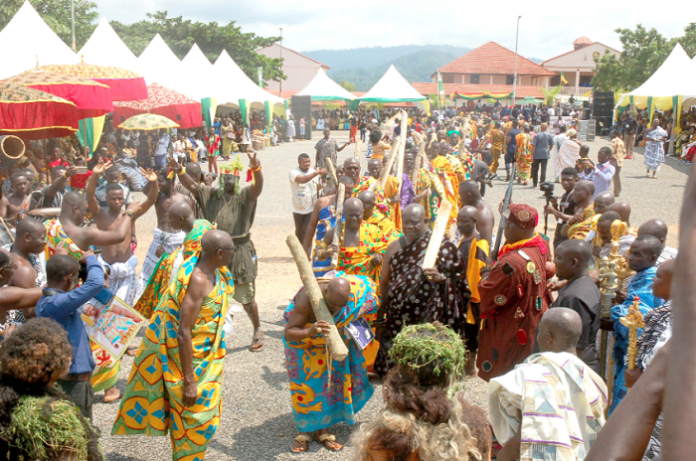The beauty of celebrating festivals in Ghana shows how great a country like Ghana is.
It is during these festivities that one learns the struggles, fights to stay alive and healthy our ancestors overcame. These celebrations are not only made for leisure purposes but to enable others, especially Africans in the diaspora trace their roots.
Today we will be looking at two symbolic festivals: the Ohum and the Adae Festivals.
The Ohum festival, celebrated on a Tuesday/Wednesday in September or October depending on the month Ohumkan festival is celebrated, witnesses a two-week ban on noise-making, prior to its celebrations.
The Akyem, a tribe in the Eastern parts of Ghana celebrate this festival to thank their creator for blessing their land with the Birim river. They use produce from their lands and the river as symbols to remember their ancestors who struggled and persevered in keeping their society intact. The people give pledges to continue the tradition and to keep their kingdom strong and free with prosperity and peace during the festival. They pledge allegiance to their king and his sub-chiefs and elders for their leadership and guidance.
Ohumkyire is celebrated to give thanks to God for the New Yam Harvest and seek His favour in the coming year. Also to celebrate the Akyem Nation.[5]
The Adae Festival which translates in the native Twi language: “resting place”, is a celebration in Ashanti. Considered a day of rest, it is the most important ancestral custom of the Ashanti people.
Within a six-week cycle, Adae has two celebration days, once on a Sunday (Akwasidae) and again on a Wednesday (Awukudae). The Adae cycle is repeated nine times a year. In observance of the Akan calendar, the ninth Adae Festival, called the Adae Kese Festival (“big Adae”), coincides with the celebration of the New Year. It is therefore celebrated to thank the gods and the ancestors for the new harvest. The festivals within Adae are not interchangeable, having been fixed from ancient times.
The preparations for the Adae are quite elaborate. The day the preparations are made is called Dapaa,(Normally on Tuesdays and Sundays). On this day, houses and the area surrounding them are all cleaned. In front of the chief’s house, drums are played by the “divine drummer” (after paying due respects to the chief), the whole evening from sunset till late night along with ceremonial songs. The chief takes a meal consisting of yam or plantain. (without salt as it is the belief that spirits do not like it).
With his processional party, he then proceeds to the chamber where the ceremonial stool (throne) is kept. The food that is left out after the chief has eaten is brought to the courtyard and sprinkled about for the dead spirits of ancestors to eat it; this is accompanied by the ringing of a bell indicative of the spirits eating the food. Consequently, the ritual continues with the sacrifice of sheep by the chief’s attendants. The blood shed during these sacrifices is used to mark the forehead and chest of the chief.
The queen-mother then offers fufu (a thick paste made of cassava or yam) to the people gathered around. Rum is then poured over the stool, and what is left is consumed by those present at the chamber. All those present at the site greet the chief, who is ceremonially seated at the open courtyard with the greetings “Adae morn”. Other ceremonial features include the court poet reciting poems that extol the deeds of the past chiefs, and drums are continuously beaten to the accompaniment of horns. The celebration runs until late at night.


